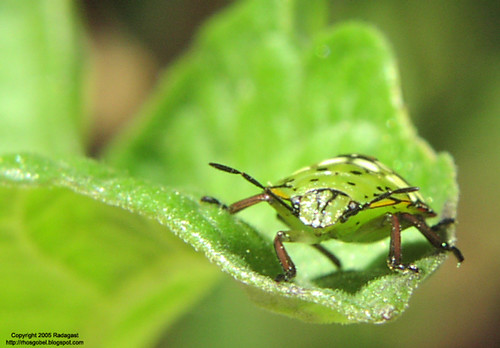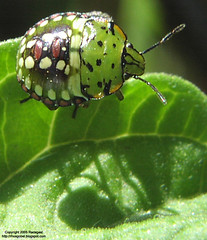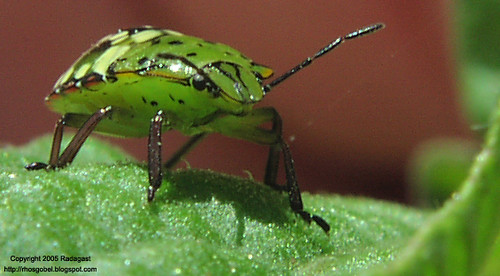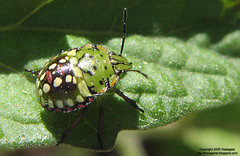
Really! It is! This bundle of cuteness is a hemipteran - a true bug (see this post for more on what a hemipteran is, and why this is one of the only organisms you can actually call a bug).
This is the nymph of a southern green stink bug (Nezara viridula), which I found on my tomato plants this past summer. I took the pictures way back in August, but never got around to posting them, so now that it's winter and I'm on vacation it seems like a perfect time to pull them out.

When I saw this crawling around on my tomato plants I immediately recognized it as a hemipteran, but I had no idea what species it was. After much searching I got the species ID from bugguide.net, where they have pages on hemipterans, stink bugs, and southern green stink bugs. I shouldn't have wasted my time hunting for the ID though, as Urtica posted the species ID as a comment on my Flickr page only minutes after I uploaded it. Thanks, Urtica!

As with all hemipterans, this insect has piercing mouthparts (which you can see in the picture above; the mouthpart is the brown tube reaching back from the insect's head on the underside of its body) that are used for feeding on fluids . In fact, while I was taking pictures I got to see the hemipteran use the tube to feed on a tomato leaf. These bugs feed primarily on tomatoes, and when they feed on the developing fruit of the tomato they can cause it to become disfigured:
When the young green fruit is injured, the cells at the site of feeding are killed by the toxic saliva injected by the bugs into the plant. This area of the fruit stops expanding, while the cells around the dead cells continue to expand by increasing their water content. The result is deformed fruit that appears to have dimples. This type of damage has been called "cat facing." When ripened or nearly ripened fruit is injured, the injection of toxic saliva merely kills a cluster of cells that later forms an off-color hard mass in the fruit, reducing fruit quality and producing a bad flavor to the fruit.For more information on these bugs, see the Texas Cooperative Extension (where the quote above comes from), the University of California IPM online, and the University of Arkansas Cooperative Extension (which includes pictures of nymphs).

Oh, and if you thought that I was being taxonomically inappropriate with my magazine cover headline, I had these pictures in mind when I created it.



No comments:
Post a Comment